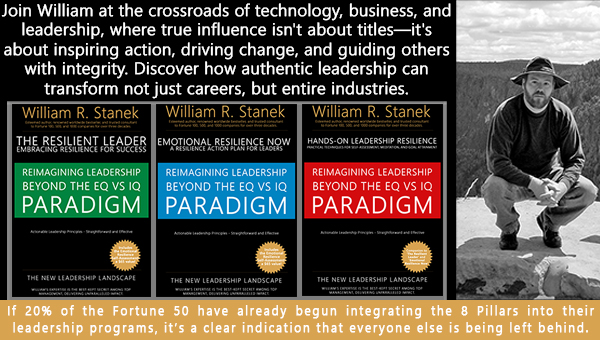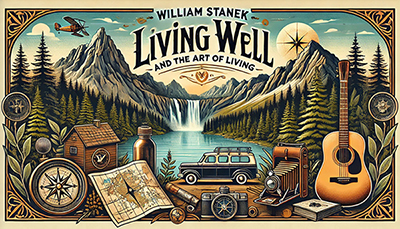
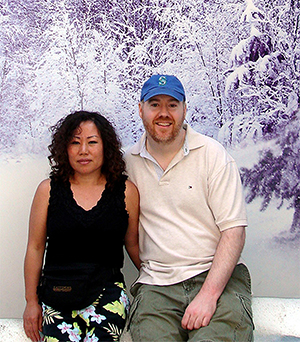
Spotlight on Life's Milestones
Life’s defining moments shape who we are and the paths we take. In this series, William and Hui Cha Stanek invite you to reflect on pivotal milestones, celebrating the journey and the lessons learned along the way.
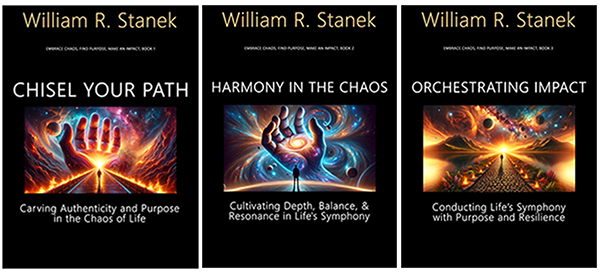
Transform your life with practical wisdom. Discover William Stanek's 'Living Well' series—your guide to a balanced and fulfilling life.
Discover William Stanek's Exclusive Art Collection
Explore and purchase the stunning art featured on this site. Own a piece of William Stanek's unique and captivating artwork today!
(April 25, 2025) Creativity in Crisis: Milestones in Innovation and Problem-Solving
Crisis often forces us to confront the unknown, pushing us to think differently, adapt quickly, and find solutions where none seem possible. These moments of challenge can be catalysts for creativity and innovation, transforming obstacles into opportunities for growth and breakthrough. Creativity in crisis is not just about survival; it’s about thriving under pressure, using the chaos of the moment to drive innovation and problem-solving. In this article, we’ll explore how moments of crisis can serve as milestones for creativity and innovation, how thinking outside the box can lead to breakthroughs, and how these principles have played out in our own personal and professional lives.
The Catalyst of Crisis: Turning Pressure into Creative Breakthroughs
Crisis often strikes without warning, throwing us into situations that demand quick thinking and rapid adaptation. In these moments, the usual ways of doing things may no longer work, and we are forced to find new paths forward. This pressure, while daunting, can also be a powerful catalyst for creativity, pushing us to think outside the box and to innovate in ways we never would have imagined under normal circumstances.
For both Hui Cha and me, some of our most significant creative breakthroughs have come in the midst of crisis. One such moment occurred early in our creative careers, when we were faced with a project that seemed destined for failure. The client had changed the scope of the project multiple times, the deadline was looming, and we were struggling to find a way to meet their expectations while staying true to our creative vision.
The pressure was intense, and the situation seemed nearly impossible. But it was precisely this pressure that sparked a breakthrough. Faced with the need to deliver something extraordinary in a short amount of time, we began to experiment with new techniques, combining elements from different disciplines and pushing the boundaries of our usual creative process. What started as a desperate attempt to salvage the project quickly turned into one of our most innovative works. The final product not only exceeded the client’s expectations but also opened up new avenues for our creative expression that we hadn’t considered before.
This experience taught us that crisis can be a powerful motivator for creativity. When the stakes are high, and the usual solutions are out of reach, we are forced to dig deeper, to tap into our most creative selves, and to find new ways of thinking and working. The pressure of the moment becomes a crucible for innovation, forging new ideas and approaches that can lead to unexpected and exciting outcomes.
The Role of Problem-Solving in Creativity: Navigating Challenges with Innovation
At the heart of creativity in crisis is the ability to solve problems. Problem-solving is not just about finding quick fixes; it’s about understanding the root of the challenge, exploring different possibilities, and coming up with solutions that are both effective and innovative. In times of crisis, problem-solving often requires us to think on our feet, to adapt to changing circumstances, and to remain open to unconventional ideas.
One of the key lessons we’ve learned about problem-solving in crisis is the importance of flexibility and adaptability. Crisis situations are often fluid, with new challenges and obstacles emerging unexpectedly. To navigate these situations effectively, it’s essential to remain flexible, to be willing to change course, and to adapt your approach as needed.
A powerful example of this in our lives came during a particularly challenging period when we were both working on multiple projects with overlapping deadlines. Each project presented its own set of challenges, from technical difficulties to creative blocks, and it quickly became clear that our usual ways of working were not going to be enough to meet these demands.
Rather than trying to force our way through using traditional methods, we decided to take a step back and rethink our approach. We began to look for ways to simplify our processes, to streamline our workflows, and to find synergies between the different projects. This meant breaking down the problems into smaller, more manageable parts, experimenting with new tools and techniques, and even collaborating more closely to share ideas and resources.
The result was a series of creative solutions that not only helped us meet our deadlines but also led to new insights and innovations in our work. By approaching the crisis with a problem-solving mindset, we were able to turn a potentially disastrous situation into a learning experience that strengthened our creative process and opened up new possibilities for future projects.
Innovation Under Pressure: How Constraints Fuel Creativity
One of the paradoxes of creativity is that constraints—whether they be time, resources, or other limitations—can actually fuel innovation. While it might seem that creativity thrives in the absence of restrictions, the reality is that constraints often push us to think more creatively, to find solutions that we might not have considered in a more open-ended situation.
In our creative journey, Hui Cha and I have often found that the most challenging constraints have led to the most innovative outcomes. For example, there was a time when we were working on a project with a severely limited budget and tight deadlines. The client’s expectations were high, and there was little room for error. At first, the constraints felt overwhelming, and we weren’t sure how we would be able to deliver what was needed with the resources available.
But rather than seeing the constraints as a barrier, we chose to view them as an opportunity to get creative. We began to explore alternative materials, techniques, and processes that were more cost-effective but still allowed us to achieve the desired results. We also looked for ways to streamline our workflow, focusing on the most essential elements of the project and finding ways to maximize impact with minimal resources.
This process of working within constraints led to some of our most innovative work. By being forced to think creatively about how to achieve our goals with limited resources, we discovered new techniques and approaches that we have since incorporated into many other projects. The experience reinforced the idea that constraints, rather than limiting creativity, can actually serve as a powerful driver of innovation.
The Emotional Journey of Creativity in Crisis: From Despair to Breakthrough
Creativity in crisis is not just about solving problems or finding innovative solutions; it’s also about navigating the emotional landscape that comes with facing difficult and uncertain situations. Moments of crisis often bring feelings of fear, anxiety, and doubt, which can be paralyzing if not managed effectively. However, these emotions can also be harnessed as fuel for creativity, driving us to push through challenges and find new paths forward.
One of the most emotionally challenging crises we faced came during a time when a major project we had been working on for months suddenly fell apart due to circumstances beyond our control. The project was something we were deeply invested in, both creatively and financially, and its collapse felt like a devastating blow. The initial reaction was one of despair—how could we recover from such a setback? What would happen to our plans and dreams that were tied to this project?
In the midst of this emotional turmoil, we realized that we had a choice: we could either give in to the despair or use it as a catalyst for something new. We chose the latter. Instead of focusing on what we had lost, we began to look for new opportunities that could arise from the situation. We asked ourselves: What have we learned from this experience? How can we apply these lessons to create something even better? What new doors might this crisis open for us?
This shift in perspective was transformative. By embracing the emotions of the moment and using them as a source of energy and motivation, we were able to turn a potential failure into a stepping stone for future success. The crisis led us to explore new creative avenues, to take risks we might not have taken otherwise, and to discover strengths and capabilities we didn’t know we had. The project that emerged from this period of crisis was not only a success in its own right but also a turning point in our creative careers, leading to new opportunities and growth.
The Ripple Effect of Creativity in Crisis: Impact on Personal and Professional Life
The creative breakthroughs that arise from moments of crisis don’t just solve immediate problems; they often have a ripple effect that extends into other areas of life. The skills, insights, and innovations developed during a crisis can be applied to future challenges, leading to continued growth and success.
In our own lives, the creative solutions we’ve developed during times of crisis have had lasting impacts. For example, the innovative techniques we discovered while working under tight constraints have become part of our regular toolkit, allowing us to approach new projects with greater confidence and creativity. The problem-solving strategies we’ve honed during difficult times have also strengthened our ability to navigate challenges in other areas of our lives, from managing relationships to making important decisions.
Moreover, the emotional resilience we’ve developed through navigating crises has deepened our sense of purpose and commitment to our work. We’ve learned that creativity is not just about coming up with new ideas; it’s about having the courage to face challenges head-on, to embrace uncertainty, and to turn obstacles into opportunities for growth. This mindset has not only enriched our creative careers but also enhanced our personal lives, helping us to approach life’s inevitable challenges with greater resilience and optimism.
Embracing Creativity in Crisis: Steps to Innovate and Solve Problems Under Pressure
Creativity in crisis is a powerful tool for innovation and problem-solving. By embracing the challenges of the moment and using them as catalysts for growth, you can develop new ideas, solve complex problems, and achieve breakthroughs that might not have been possible otherwise.
Here are a few steps you can take to embrace creativity in crisis and turn challenges into opportunities for innovation:
-
Embrace the Pressure: Recognize that pressure can be a powerful motivator for creativity. Instead of resisting the stress of the situation, use it as fuel to push yourself to think differently and explore new possibilities.
-
Break Down the Problem: In moments of crisis, complex problems can feel overwhelming. Break the problem down into smaller, more manageable parts, and tackle each one systematically. This approach can help you find creative solutions step by step.
-
Think Outside the Box: Crisis situations often require unconventional solutions. Be open to exploring new ideas, techniques, and approaches that you might not have considered under normal circumstances.
-
Use Constraints to Your Advantage: Rather than seeing constraints as limitations, view them as opportunities to innovate. Use the boundaries of the situation to inspire creative thinking and find new ways to achieve your goals.
-
Stay Flexible and Adaptable: Crisis situations are often fluid and unpredictable. Stay flexible in your approach, be willing to adapt as circumstances change, and remain open to new opportunities that may arise.
-
Harness Your Emotions: Acknowledge the emotions that arise during a crisis, whether they be fear, anxiety, or frustration. Use these emotions as a source of energy and motivation to drive your creativity and problem-solving efforts.
The Transformative Power of Creativity in Crisis: Innovating Under Pressure
Creativity in crisis is a transformative force that can turn challenges into opportunities for innovation and growth. By embracing the pressure of the moment, thinking outside the box, and using constraints to your advantage, you can achieve creative breakthroughs that lead to personal and professional success.
For Hui Cha and me, the moments of crisis we’ve faced in our creative careers have been some of the most significant milestones in our journey. They have pushed us to think differently, to innovate under pressure, and to discover new strengths and capabilities. As we continue on our journey of living well, we remain committed to embracing creativity in crisis, knowing that it is a key to turning challenges into opportunities and achieving breakthroughs that drive our growth and success.
A Call to Action: Embrace Creativity in Crisis and Innovate Under Pressure
Creativity in crisis is a powerful tool for innovation and problem-solving. By embracing the challenges of the moment and using them as catalysts for growth, you can develop new ideas, solve complex problems, and achieve breakthroughs that might not have been possible otherwise.
Here are a few steps you can take to embrace creativity in crisis:
-
Recognize the Potential of Pressure: Use the pressure of the moment as a motivator for creativity. Let the challenges you face push you to think differently and explore new possibilities.
-
Break Down Complex Problems: Approach complex problems by breaking them down into smaller parts. This makes them more manageable and opens up opportunities for creative solutions.
-
Explore Unconventional Solutions: In times of crisis, be open to unconventional ideas and approaches. Think outside the box and consider new ways to achieve your goals.
-
Use Constraints as Inspiration: View constraints as opportunities to innovate. Use the boundaries of the situation to inspire creative thinking and find new paths forward.
-
Stay Flexible and Adaptable: Remain flexible in your approach and be willing to adapt as circumstances change. Embrace new opportunities that arise and be open to changing course if needed.
-
Channel Your Emotions into Creativity: Acknowledge and harness the emotions that arise during a crisis. Use them as a source of energy and motivation to fuel your creativity and problem-solving efforts.
Creativity in crisis is a powerful and transformative force. By embracing this milestone, you can innovate under pressure, solve complex problems, and turn challenges into opportunities for growth and success.
Embrace creativity in crisis, innovate under pressure, and continue on your journey of living well.
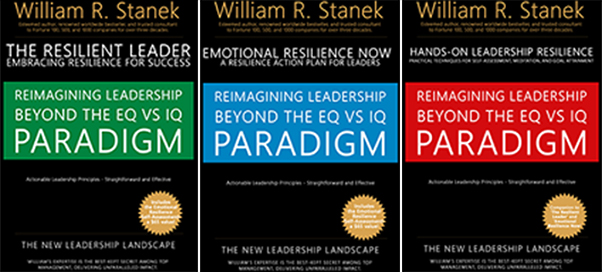
Join William at the crossroads of technology, business, and leadership, where true influence isn't about titles - it's about inspiring action, driving change, and guiding others with integrity. Discover how authentic leadership can transform not just careers, but entire industries.
Bring Inspiration Home
Enhance your space with William Stanek's evocative art. Each piece is crafted to inspire and uplift your everyday life.
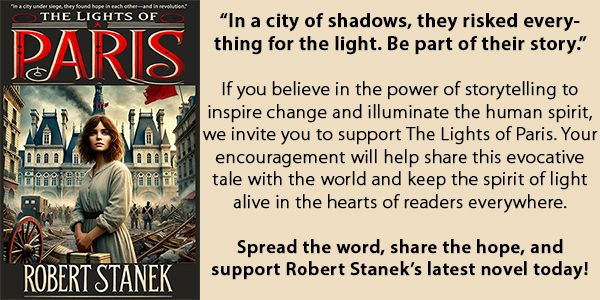
Support The Lights of Paris by Robert Stanek, William Stanek's pen name! Through vivid historical detail and deeply moving character stories, Robert takes readers on an unforgettable journey through one of history’s most transformative times.
